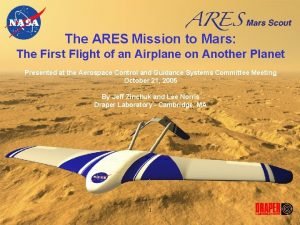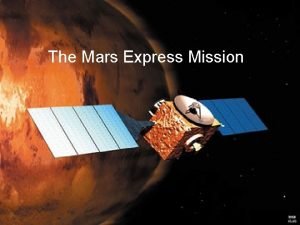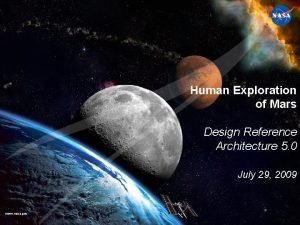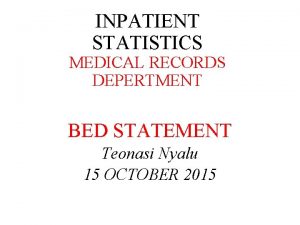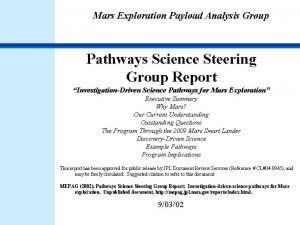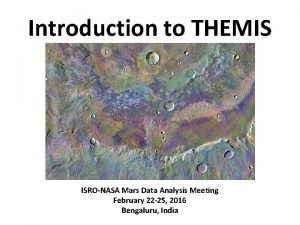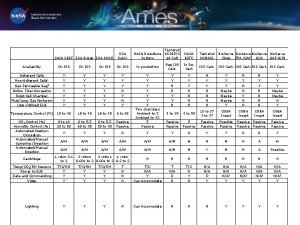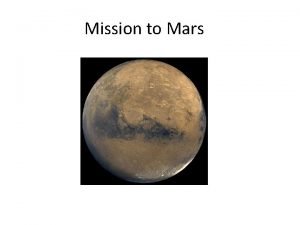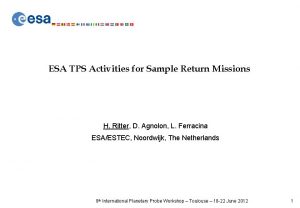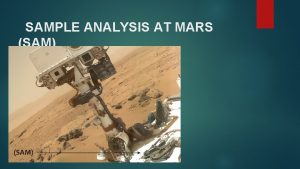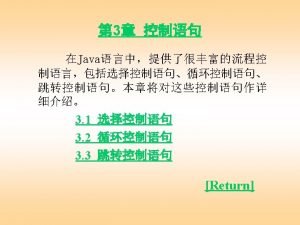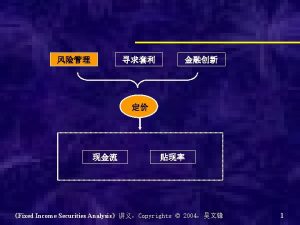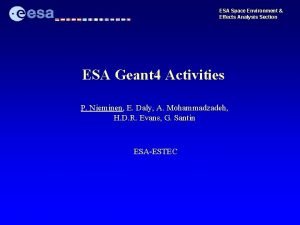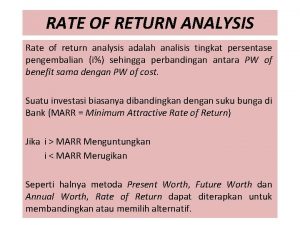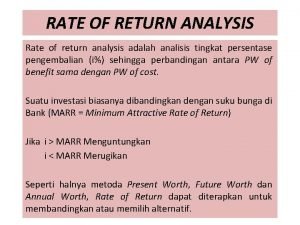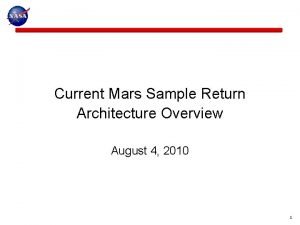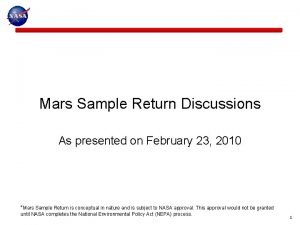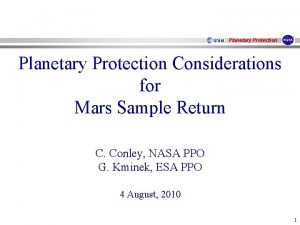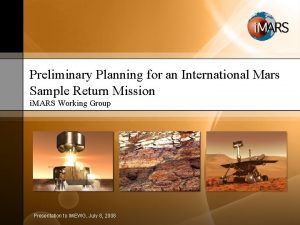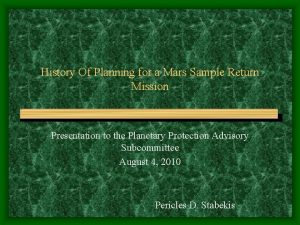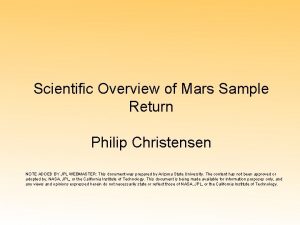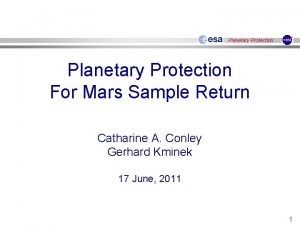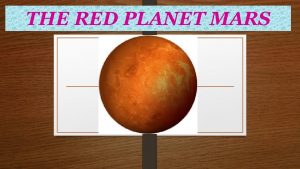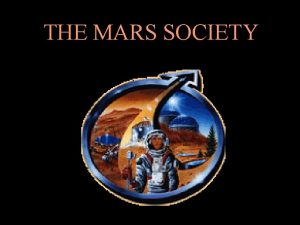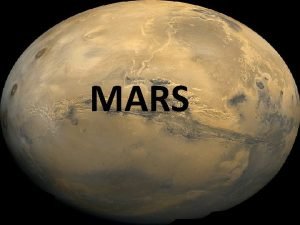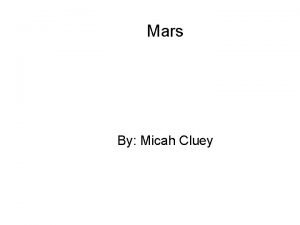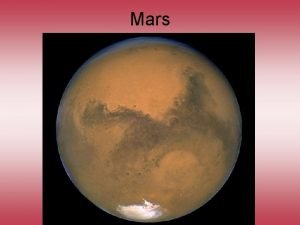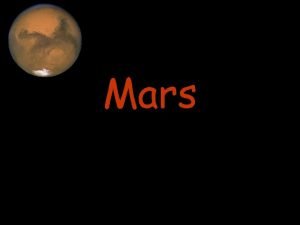Mars Sample Return Mission Analysis for an ESA






































- Slides: 38

Mars Sample Return: Mission Analysis for an ESA Earth Return Orbiter Eric Joffre, Uwe Derz, Marie-Claire Perkinson (Airbus) Jakob Huesing, Friederike Beyer, and Jose-Manuel Sanchez Perez (ESA) 7 th International Conference on Astrodynamics Tools and Techniques 6 -9 November 2018, DLR Oberpfaffenhofen, Germany

Mars Sample Return (MSR) Campaign Overview Ø Three missions to be separately launched in the 2020 s 2 • Mars 2020 (M 2020) Rover for samples acquisition and caching • Sample Return Lander (SRL) Surface platform, Sample Fetch Rover (SFR), and Mars Ascent Vehicle (MAV) • Earth Return Orbiter (ERO) Rendezvous and capture of the Orbiting Sample (OS), bio-sealing, Earth Re-entry Capsule (ERC) 07 November 2018

Mars Sample Return (MSR) Campaign Overview Ø Three missions to be separately launched in the 2020 s • Mars 2020 (M 2020) Rover for samples acquisition and caching • Sample Return Lander (SRL) Surface platform, Sample Fetch Rover (SFR), and Mars Ascent Vehicle (MAV) • Earth Return Orbiter (ERO) Rendezvous and capture of the Orbiting Sample (OS), bio-sealing, Earth Re-entry Capsule (ERC) Ø Earth Return Orbiter identified as a strong candidate for an ESA contribution to the campaign 3 07 November 2018 Scope of the ESA Mars Sample Return Architecture Assessment Study

Mission Analysis – Investigated Mission Phases and Key Driving Requirements Phase Tasks Launch Select Launch Vehicle Interplanetary transfers: outbound and inbound Select propulsion type Optional: Select stage separation point Mars Orbit Insertion (MOI) Select propulsion type Select insertion orbit Optional: Select stage separation point Apocentre reduction Select propulsion type or aerobraking Select aerobraking initial apocentre altitude Assess comms relay performance, including during aerobraking Optional: Select stage separation point Rendezvous with Select orbit inclination Orbiting Sample Investigate rendezvous timeline • • Apocentre raising and Trans-Earth Select propulsion type Injection (TEI) Earth re-entry 4 Assess Earth re-entry conditions/interface 20 August 2018 • The mission shall be launched by an Ariane 6 from Kourou (baseline). The mission shall be designed for a launch in 2026 (2028 backup). The mission design shall be compatible with an Orbiting Sample (OS) container arrival no earlier than early 2028 (2030 for a 2028 lander launch). The mission shall provide communications relay functions to the surface mission, covering the Entry, Descent and Landing (EDL) of the SRL, the surface operations until MAV launch and the MAV launch phase. NB The EDL coverage constraint was later reformulated as a mission design goal, rather than a strict requirement. The mission should return the samples by 2030.

Interplanetary Transfers with Chemical Propulsion (CP) Ø Outbound and inbound opportunity maps example: short transfers departing between 2026 and 2030 • Solution space for short ballistic transfers well known and documented • Key design parameters for the evaluation of the architectures are: departure and arrival V-infinity (launcher performance, MOI/TEI Delta-V, Earth entry conditions), departure and arrival declination, (launcher performance, LMO inclination compatibility, Earth entry conditions) departure and arrival dates (timeline) • Solution space characterised by energy optimal opportunities every ~26 months, with minimum departure/arrival V-infinity typically around 3 km/s

Interplanetary Transfers with Chemical Propulsion (CP) Ø Declination and Launch Vehicle (LV) considerations: • Baseline Launch Vehicle is Ariane 64: injection performance not available mass estimates based on Proton • Nominal performance assumption gives a declination range, possibly extended to +/- 35 deg to be confirmed, higher performance expected for near equatorial launch • Near zero declination launch constraint mandates the use of Deep Space Manoeuvres (DSMs) to compensate • Alternatively, consider eg Falcon Heavy / Delta IV Heavy: all declinations between +/ - 28 deg accessible without significant penalty Ø “Extra-short” transfers also considered to increase time available at Mars, with slightly suboptimal dates compared to energy optimal solutions Ø Backup mission (relaxed timeline) architectures can use long transfers (more than one heliocentric revolution) and Earth Gravity Assist (EGA) options Ø CP transfer dates assessed: • Outbound transfers: 2026, 2028 • Inbound transfers: 2028, 2030, 2032 6 07 November 2018

Interplanetary Transfers with Electric Propulsion (EP) Ø Solar Electric Propulsion (SEP) augmented transfers from Earth to Mars can: • Reduce Earth departure V-infinity increase launcher injection mass • Reduce Mars arrival V-infinity reduce CP orbit insertion Delta-V • Perform required Deep Space Manoeuvres (e. g. to compensate for constrained declination) at lesser propellant mass impact Ø SEP transfers from Mars to Earth can: • Reduce Mars departure V-infinity reduce CP planetary escape Delta-V • Reduce Earth arrival V-infinity reduce aerothermodynamic loads on ERC Ø In both cases, additional freedom in the departure and arrival dates Ø Strong interaction between trajectory and spacecraft design. A key driving parameter is the available thrust to mass ratio at 1 au and the evolution with heliocentric distance: • Size and technology of the Solar Arrays maximum available power • Number and type of thrusters, throttling capability available thrust to mass ratio Ø Increased operational complexity, likely to require forced coast arcs for Orbit Determination and operational contingency Ø Database of SEP transfers with parametric variation on: departure/arrival dates, departure/arrival V-infinity, thrust to mass at 1 au, thrust evolution model

Low Mars Orbit (LMO) Inclination Trade-Off Ø Mars Orbit not driven by science requirements as was the case for concepts involving a NASA orbiter (e. g. Ne. MO) Ø The only orbit parameter open to trade-off is the inclination Ø Objective: investigate options and relevant trade-off for possible Delta-V / duration reduction Ø The selection of the LMO inclination is a driver to all mission phases from MOI to DOA Ø Trade-off conducted, assessing (see summary table): • Drift of the Right Ascension of the Ascending Node (RAAN) owing to Mars J 2: both absolute (for DOA) and relative (for OS detection, Orbit Matching and rendezvous) • MAV launch considerations • Communications with Earth • Eclipses: range of possible durations • Compatibility with MAV launch pad latitude and interplanetary transfers (declination) Ø Proposed LMO inclination baseline of 40 deg 8 07 November 2018 Trade-Off driver Low inclination (e. g. ~ 20 deg) High inclination (e. g. ~ 75 deg) Rationale RAAN absolute drift rate Fast Slow RAAN phasing for Departure Orbit Acquisition (DOA) Slow OS detection & Orbit Matching (w/o MAV LST constraint) RAAN relative drift rate Fast MAV opportunities Right Ascension separation, for given launch pad latitude Small (0 for i = launch pad latitude) Large Orbiter visibility from Earth during MAV ascent Eclipses minimum duration (minor) Longer Shorter Power / thermal Limitation wrt MAV launch Minimum value = launch pad latitude (18. 5 deg TBC) Performance (value TBC) - Limitation wrt arrival / departure conditions Minimum value (declination, transfer dependent) N/A -

Mars Orbit Insertion (MOI) All possible pre/post-MOI orbits Case 1 MOI orbit (i = 40 deg, Ao. P = -77 deg) Arrival hyperbola Case 2 MOI orbit (i = 40 deg, Ao. P = 155 deg) 40 deg inclination cases 9 07 November 2018 Equator

Target Orbit Acquisition: Apocentre Reduction and Aerobraking (A/B) Ø The default assumption for preliminary budgets is to start aerobraking from a 1 sol orbit, as was done by Exo. Mars Trace Gas Orbiter (TGO) ΔV max MOI 300/300 TOA = 1323 m/s Ø This means that the spacecraft needs to perform a manoeuvre (ΔV ~ 140 m/s) to reach the initial A/B altitude from the post-MOI orbit Ø This baseline can be modified to: • • 10 Decrease the associated Delta-V, by starting A/B with a higher apocentre (increases A/B duration): max Delta-V saving = 137 m/s Decrease the duration, by starting the A/B with a lower apocentre: rapid Delta-V increase 07 November 2018 A/B starting at 1 sol 34000 km apocentre ΔV MOI A/B = 137 m/s

Communications With Lander During Aerobraking Ø No detailed aerobraking scenario optimisation performed in the context of the study Ø Simplified semi-analytical orbit propagation model based on parametric description of the apocentre profile, and first-order drift models for RAAN, Ao. P and anomaly (J 2 only) Ø Complex orbit evolution: combination of: apocentre decay, Ao. P drift and RAAN drift Ø Quantitative metrics for opportunities of communication links derived for sample arrival transfer case, considering two landing sites: Jezero Crater and Columbia Hills Jezero Crater 11 loci of pericentre

Communications With Lander During Aerobraking Ø Ø Assessment of the total (cumulated) and daily contact time between the orbiter (ERO) and the lander (SRL) during aerobraking Parametric analysis of the impact of the initial longitude (wrt Martian surface, which can be finely tuned by proper arrival timing) Assessment of the impact of the additional constraint to have the lander in sunlight to communicate (power limitation) Constraints considered: minimum elevation = 10 deg, minimum altitude = 350 km, maximum range = 20000 km 1 curve/colour = 1 assumption for initial longitude value 12 07 November 2018

Timeline Between MAV Ascent and TEI Ø Proposed timeline for nominal operations between MAV ascent and TEI Phase Events Duration MAV ascent Time OS detection (NAC) (ERO-relative frame) T 0 OS detection 14 days T 0 + 14 days Hohmann transfer / "Homing" 2 days T 0 + 16 days Co-elliptic approach / Far Rd. V ~120 km to 5 km 2 days T 0 + 18 days Final approach / Close Rd. V ~5 km to 100 m 2 days T 0 + 20 days Forced translation, capture and bio-sealing 2 days T 0 + 22 days Absolute RAAN phasing (assuming 200 deg) 24 days T 0 + 46 days Apocentre raising to 4 sols 14 days T 0 + 60 days Orbit Matching Rendezvous and Capture Departure Orbit Acquisition Trans-Earth Injection (TEI) T 0 + 60 days Ø 90 days conservatively assumed for the timelines, in order to account for possible contingencies e. g. requiring 2 rendezvous attempts 13 07 November 2018 Co-elliptic approach (OS-relative frame)

Hyperbolic approach orbits ERC Re-entry Conditions – Overview Ø Entry trajectory characteristics are influenced by the atmospheric velocity and the Flight Path Angle (FPA) at the Entry Interface Point (EIP @ 120 km) Ø Maximum dynamic pressure and kinetic heating are key driving parameters for the aerothermodynamic loads and therefore the design of the ERC Terminator Earth shadow Ø The FPA can be chosen freely without Delta-V penalty via approach orbit pericentre altitude targeting: entry angles in [8 -15] deg typically considered Sun vector at EIP Locus of EIP and entry arcs Ø Key factors are Earth approach V-infinity, declination, and orientation wrt Sun: • V-infinity determines inertial velocity at EIP, typically required < 13 km/s • Declination determines the latitude of the centre of the landing locations • Orientation wrt Sun line determines admissible Local Solar Time at EIP Ø For a given return trajectory, loci of possible pericentre locations are obtained by sweeping the approach velocity vector in the B plane (B-plane targeting): • Implications for prograde (atmospheric velocity < inertial velocity) or retrograde (atmospheric velocity > inertial velocity) entry trajectory • Possibility to target a landing site e. g. Utah (40 deg N), Woomera (31 deg S) • For a typical tangential Earth approach night or day landings can be chosen Ø Verification of compliance with Earth entry requirements necessary for all candidate transfers 14 07 November 2018 Re-entry conditions for 2028 -T 1 CP return transfer example

Conclusion and Future Work Ø Based on the outcomes of the mission analysis, a number of mission architectures investigated: including purely chemical (CP) as well as hybrid (CP and EP stages) options Ø Most promising down-selected for further analysis, including preliminary spacecraft architecture Ø Target sample return date found to be incompatible with current assumptions for the baseline Launch Vehicle performance and payload mass Ø 2018: Airbus awarded the Mars Sample Return Earth Return Orbiter (MSR-ERO) Phase A/B 1 system study by the ESA, and thus given the opportunity to pursue its contribution to the MSR campaign, working in close collaboration with ESA and NASA JPL Ø Mission analysis and architecture trade-offs still currently ongoing, looking in particular at higher power options for some EP architectures as well as alternative CP transfer options for the relaxed timeline Ø Phase A to be completed before end of 2018, and Phase B 1 before the ministerial council 2019 (CM 19) 15 07 November 2018

Thank you – Any questions ?

Backup slides MSR-AA Study objectives

Mars Sample Return Architecture Assessment Ø Mars Sample Return Architecture Assessment (MSR-AA) study overview • 4 months study conducted by Airbus for the European Agency between July and November 2017 • Airbus strong heritage in designing Sample Return missions and missions to Mars, in particular Airbus conducted the MSRO Phase A in 2011 -12 for ESA Ø Objectives of the study 1. Quantify different mission architectures of the Mars Sample Return campaign 2. Support identification and selection of ESA contributions to the campaign 3. Identify design envelopes and ranges for specific input parameters based on these possible architectures, for the elements that could be contributed by ESA 4. Provide inputs to the technology development planning 5. Support ESA’s interactions with NASA on the planning of a joint MSR mission 18 07 November 2018

Backup slides LMO Inclination trade-off

Introduction and main motivations Ø Focus on Mars proximity phases in particular: • Mars Orbit Insertion to Target Orbit Acquisition (TOA) • MAV/OS launch, Rendezvous (Rd. V) and OS capture • Departure Orbit Acquisition (DOA) prior to Mars escape Ø Challenge: • Main focus and priority given to the architecture D mission with very tight timeline and ΔV budget • Objective: investigate options and relevant trade-off for possible ΔV / duration reduction Ø Durations essentially driven by RAAN drift considerations: • Relative (OS/SRO) RAAN phasing for rendezvous with the OS after MAV injection • Absolute RAAN phasing to match the conditions for Mars escape Ø Main assumptions: • Mars Orbit Insertion (MOI) into a Highly Elliptical Orbit of period ~ 4 sols: apocentre ~96, 000 km and pericentre ~300 km • Low Mars Orbit (LMO) corresponds to the OS orbit after injection by the MAV: assumed to be ~ 343 km attitude circular orbit • A priori RAAN can take any arbitrary value at arrival and at Mars departure • Remaining degree of freedom for the LMO: inclination Ø The selection of the LMO inclination is a driver to all mission phases from MOI to DOA 07 November 2018

Right Ascension of the Ascending Node (RAAN) drift and drift rate Ø Ø Ø At a similar altitude, J 2 perturbation in a Low Mars Orbit is stronger than in a Low Earth Orbit Causes secular drift rate of the Right Ascension of the Ascending Node (RAAN), and Argument of Pericentre (Ao. P, if elliptical orbit) Significant variation with (circular orbit) altitude and inclination – initial baseline (MAG) was 343 km / 75 deg leading to -3 deg/ day For given Mars escape conditions at a given date (V∞ vector), two values of the RAAN are admissible This typically requires up to ~ 180 degrees absolute rotation of the line of nodes: for a baseline inclination of 75 deg, this could take 2 months, down to ~ 18 days at 25 deg 75 deg 40 deg 25 deg Altitude = 343 km Inclination = 75 deg Duration = 2 months Example orbits at different inclinations

Relative RAAN phasing Ø Minimum altitude differential between the orbiter (SRO) and the OS after injection by the MAV, driven by: • MAV injection dispersions – ∆a = +/- 30 km – ∆e ≤ 0. 02 – (∆i = +/- 0. 5 deg) • Orbit determination performance for the orbiter Ø OS must be launched with a RAAN differential wrt SRO so that it catches up (Orbit Matching) during the time allocated for Rd. V operations Ø RAAN separation must be large enough or RAAN to ensure there is no RAAN “overshoot” during that time in favour of slow relative RAAN drift / high inclination Ø Possible conflict with MAV ascent coverage / OS detection issue Clarification from ESA/JPL: The SRO will be required to receive the MAV telemetry during and after its ascent. The current design has the MAV transmitting on UHF band to be received by an orbiter with a UHF relay package similar to the on TGO or MAVEN. Ø Assessed during MSRO study but unlikely to be a major issue (large range) 22 07 November 2018

MAV launch considerations wrt RAAN relative phasing Ø If the MAV launch (solar) time was constrained • Then the RAAN of the OS would be constrained – Inclination = latitude of the launch pad 1 value of RAAN imposed for the OS Possible very long relative RAAN phasing – Inclination > latitude 2 values of OS RAAN possible (North or South launch) worst case RAAN phasing duration reduced Would impact the inclination trade-off Ø If no constraint is put on the launch time, then the relative RAAN phasing duration can be very short (up to maximum of a few days, depending on orbit determination performance) Assumed baseline, confirmed by ESA / JPL 23 07 November 2018

Relative RAAN phasing Ø Map showing relative RAAN drift rate as a function of (absolute) inclination and OS/SRO altitude differential (∆e = 0, ∆i = 0 assumed) 24 07 November 2018

MAV launch considerations wrt inclination Ø For a given launch pad latitude (Φ): • • • The minimum inclination is given by the launch pad latitude: imin = Φ For an inclination equal to the latitude of the launch pad latitude - Only one launch opportunity per sol - Launch azimuth = 90 deg towards East For an inclination greater than the latitude of the launch pad latitude - Two launch opportunities every sol - Launch either towards North or towards South Ø The orbiter needs to be in visibility of Earth during MAV ascent • If one launch opportunity is not, the other may be if enough separation Higher inclination ensuring larger separation of launch opportunities Right Ascensions / longitudes are favourable Ø However, this is essentially driven by the latitude of the MAV launch pad • For example always 180 deg separation in case of an equatorial launch, for all inclinations > 0 25 Mars rotation in inertial frame 07 November 2018 Orbiter Launch opportunity #1 and #2 (same day) Example with 40 deg inclination and 20 deg launch pad latitude X, Y, Z = inertial axes MAV launch pad latitude

MAV launch considerations wrt inclination Ø Admissible Launch Right Ascension as a function of latitude and inclination Mars rotation in inertial frame Orbiter Example South (top) & North (bottom) opportunities Launch opportunity #1 and #2 (same day) Example with 40 deg inclination and 20 deg launch pad latitude X, Y, Z = inertial axes 26 07 November 2018 For a given launch pad latitude, higher inclinations lead to larger separation in launch opportunities time / Right Ascension MAV launch pad latitude

Eclipses Ø Duration of eclipses around Mars as a function of altitude (circular orbit) and Solar β angle 27 07 November 2018

βmax for inclination = 0 10 20 30 40 Eclipses Ø OS orbit assumed to be on a circular orbit at 343 km (+/- 30 km) § Orbital period ~ 2 hours (~6940 s = 1 hour 56 minutes) Ø Eclipse duration function of the solar β angle = angle between orbital plane and Sun vector (see top-right figure) Ø Solar β angle comprised between +/- βmax = i + ε (see bottom-right figure) • i = inclination – subject to trade-off • ε = angle to the ecliptic = 25. 19 deg for Mars Eclipse duration as a function of the solar β angle Ø Instantaneous Solar β angle function of the orbit’s inclination, Right Ascension of the Ascending Node, and of the aerocentric Solar Longitude Ls (date / Mars season) There will be eclipses every orbit for i ≤ 40 deg • Maximum duration 42 minutes (worst case, βmin = 0) • Minimum duration function of the inclination (best case, βmax) • The higher the inclination the lower the minimal eclipse duration (e. g down to 0 for 40 deg inclination) 28 07 November 2018 Solar β angle extreme values deg

Summary and LMO / OS inclination trade-off Trade-Off driver RAAN absolute drift rate Low inclination Fast High inclination Rationale Slow RAAN phasing for Departure Orbit Acquisition (DOA) RAAN relative drift rate Fast Slow OS detection & Orbit Matching (w/o MAV LST constraint) MAV opportunities Right Ascension separation, for a given launch pad latitude Small (0 for i = launch pad latitude) Large Orbiter visibility from Earth during MAV ascent Eclipses minimum duration (minor) Longer Shorter Power / thermal Limitation wrt MAV launch Minimum value = launch pad latitude (18. 5 deg TBC) Performance (value TBC) - Limitation wrt arrival / departure conditions Minimum value (declination, transfer dependent) N/A - 29 07 November 2018

LMO inclination proposed baseline Ø As a result from this trade-off, an inclination of ~40 deg is proposed as a preliminary baseline for the architecture D mission: • Absolute RAAN drift rate = -8. 25 deg / day • Corresponding duration to achieve 200 deg RAAN drift duration = 24 days (instead of ~ 2 months allocation previously) • Orbital plane Ecliptic plane Relative RAAN drift rate = 0. 4 deg / day (or ~ 24. 6 deg per 2 months) (assuming 50 km altitude differential) • MAV/OS launch opportunities RA separation = 128 deg (assuming 20 deg launch pad latitude) • MAV/OS launch opportunities time separation = 29 minutes (assuming 20 deg launch pad latitude) • Solar Beta Angle in [0 - 65. 19] deg interval Equatorial plane Example h = 343 km, i = 40 deg (Ω = 0 deg) • 30 Eclipses duration in [2 - 42] minutes interval 07 November 2018

Backup slides Rendezvous operations

Rendezvous: OS Detection, Homing, Co-elliptic and Final Approach Ø Ø Ø Earth Return Orbiter (ERO) initially on a higher orbiter than Orbiting Sample (OS) after MAV injection 1. OS detection by means of RF sensor together with Narrow Angle Camera (NAC): data sent to ground for orbits restitution 2. Orbit Matching: Hohmann (“Homing”) transfer to a few km above OS 3. Co-elliptic approach within NAC sensor field of view, Wide Angle Camera (WAC) acquisition (~ 50 km) 4. Final approach, Li. DAR acquisition (~ 5 km), forced translation and OS capture 1. OS detection (NAC) (ERO-relative frame) 2. Hohmann transfer to ~ OS altitude (OS-relative frame) 32 07 November 2018 3. Co-elliptic approach (OS-relative frame)

Timeline Between MAV Ascent and TEI Ø Proposed timeline for nominal operations between MAV ascent and TEI Phase Events Duration MAV ascent Time T 0 OS detection 14 days T 0 + 14 days Hohmann transfer / "Homing" 2 days T 0 + 16 days Co-elliptic approach / Far Rd. V (~120 km to 5 km) 2 days T 0 + 18 days Final approach / Close Rd. V (~5 km to 100 m) 2 days T 0 + 20 days Forced translation, capture and bio-sealing 2 days T 0 + 22 days Absolute RAAN phasing (assuming 200 deg) 24 days T 0 + 46 days Apocentre raising to 4 sols 14 days T 0 + 60 days Orbit Matching Rendezvous and Capture Departure Orbit Acquisition Trans-Earth Injection (TEI) T 0 + 60 days Ø 90 days conservatively assumed for the timelines, in order to account for possible contingencies e. g. requiring 2 rendezvous attempts 33 07 November 2018

Backup slides ERC re-entry conditions

Hyperbolic approach orbits 2030 -T 2 CP return transfer example – Summary Arrival Date 17/09/2031 Ø XXXXX Vx Vy Vz 3. 958 1. 923 2. 708 V∞ magnitude Declination Right Ascension 5. 167 31. 608 25. 913 Arrival Vinf (EME 2000, km/s) Arrival Vinf (EME 2000, km/s, deg) Case Entry FPA - 15 deg EIP osculating pericentre altitude (km) 13. 0 Entry FPA - 13 deg -81. 7 Entry FPA - 11 deg -160. 8 Entry FPA - 8 deg -252. 5 Re-entry site Utah prograde Utah retrograde Woomera prograde Woomera retrograde Utah prograde Utah retrograde Woomera prograde* Woomera retrograde* *feasibiliy tbc with more detailed simulations Entry arcs Relative velocity at Local Solar Time at EIP (km/s) EIP (hours) 11. 91 12. 54 12. 03 12. 42 11. 90 12. 55 12. 07 12. 38 11. 89 12. 56 12. 14 12. 31 11. 88 12. 57 N/A Sun vector at EIP 20. 1 8. 1 23. 9 4. 3 20. 4 7. 8 0. 4 3. 80 20. 7 7. 5 1. 2 3 21. 1 7. 1 N/A *Impact at higher latitude than target landing site Terminator Earth shadow Equator FPA = - 8 deg illustration Ø Main conclusions: • High V∞ and high declination approach • Higher atmospheric velocities • Woomera landing impossible unless a very steep reentry is performed, with a near South-North azimuth (polar approach) • Utah landing possible for all FPA: night prograde entries and day-time retrograde entries

2030 -T 2 CP return transfer example – Entry plots Ø Local Solar Time (X axis) vs planetocentric latitude (Y axis) 36 07 November 2018 Ø Relative re-entry velocity (X axis) vs planetocentric latitude (Y axis)

Backup slides Example timeline

Example Timeline for Hybrid Architecture Mission 38 26 November 2020
 Esa multimedia.esa.int./multimedia/virtual-tour-iss
Esa multimedia.esa.int./multimedia/virtual-tour-iss Ares mission to mars
Ares mission to mars Mars express mission
Mars express mission Exploration sur mars
Exploration sur mars Daily bed return sample
Daily bed return sample Mars exploration program analysis group
Mars exploration program analysis group Mars data analysis software
Mars data analysis software Iso 22301 utbildning
Iso 22301 utbildning Typiska novell drag
Typiska novell drag Nationell inriktning för artificiell intelligens
Nationell inriktning för artificiell intelligens Ekologiskt fotavtryck
Ekologiskt fotavtryck Varför kallas perioden 1918-1939 för mellankrigstiden?
Varför kallas perioden 1918-1939 för mellankrigstiden? En lathund för arbete med kontinuitetshantering
En lathund för arbete med kontinuitetshantering Adressändring ideell förening
Adressändring ideell förening Tidböcker
Tidböcker Anatomi organ reproduksi
Anatomi organ reproduksi Vad är densitet
Vad är densitet Datorkunskap för nybörjare
Datorkunskap för nybörjare Boverket ka
Boverket ka Debattartikel mall
Debattartikel mall För och nackdelar med firo
För och nackdelar med firo Nyckelkompetenser för livslångt lärande
Nyckelkompetenser för livslångt lärande Påbyggnader för flakfordon
Påbyggnader för flakfordon Lufttryck formel
Lufttryck formel Svenskt ramverk för digital samverkan
Svenskt ramverk för digital samverkan Kyssande vind
Kyssande vind Presentera för publik crossboss
Presentera för publik crossboss Vad är ett minoritetsspråk
Vad är ett minoritetsspråk Plats för toran ark
Plats för toran ark Klassificeringsstruktur för kommunala verksamheter
Klassificeringsstruktur för kommunala verksamheter Mjälthilus
Mjälthilus Bästa kameran för astrofoto
Bästa kameran för astrofoto Centrum för kunskap och säkerhet
Centrum för kunskap och säkerhet Byggprocessen steg för steg
Byggprocessen steg för steg Mat för unga idrottare
Mat för unga idrottare Verktyg för automatisering av utbetalningar
Verktyg för automatisering av utbetalningar Rutin för avvikelsehantering
Rutin för avvikelsehantering Smärtskolan kunskap för livet
Smärtskolan kunskap för livet Ministerstyre för och nackdelar
Ministerstyre för och nackdelar

